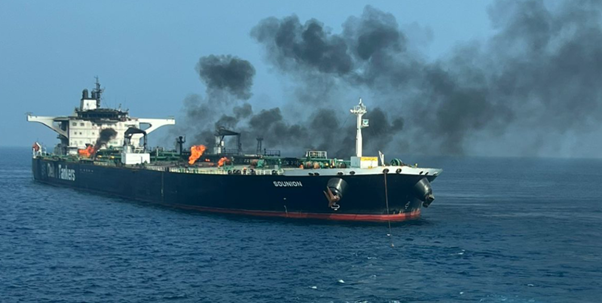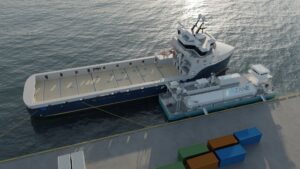
Security specialist in maritime Ambrey confirmed on Friday the successful salvage of the oil tanker Sounion following an attack by Houthis on August 21 last year. The inside story of the salvage response of the oil tanker, an extremely difficult and dangerous task in the midst of a war zone was revealed by Ambrey.
The Greek-flagged oil tanker Sounion was targeted by Houthi militants in the southern Red Sea last year. The Iran-backed group Yemen’s Houthis posted videos in the social media showing their forces’ blowing up of the Greek-flagged tanker Sounion, whose crew has been forced to abandon the ship after a series of attacks on August 21. A screen grab from a video posted on X shows the tanker after it had been struck.
Following an urgent distress call on August 22 from the ship’s captain, the European Naval Force (EUNAVFOR), Operation “ASPIDES”, swiftly dispatched a naval asset (a French frigate) to execute a rescue operation of the crew.
Despite continued attacks by unmanned surface vessels (USVs) and unmanned aerial vehicles (UAVs), all crew members were safely evacuated by ASPIDES’ asset.
The following day Houthis boarded the vessel before detonating explosive charges on the main decks and bridge which started 19 fires and breached her cargo tank tops, as Ambrey said in its statement.
A commercial salvage operation was launched by the vessel insurers, which was led by Ambrey.
The US State Department issued a statement claiming the vessel risked an oil spill into the Red Sea ‘four times the size of the Exxon Valdez disaster’.
Following the attack on the MV Sounion in the Red Sea Mr. Arsenio Dominguez, secretary-general of the International Maritime Organization (IMO) said: “I am extremely concerned about the situation regarding the tanker MV Sounion which was targeted while transiting the Southern Red Sea. The tanker is carrying some 150,000 tonnes of oil on board, that is approximately one million barrels of crude oil.
“The risk of an oil spill, posing an extremely serious environmental hazard, remains high and there is widespread concern about the damage such a spill would cause within the region.”
As it is reported by Ambrey, the extensive firefighting mission required to make the vessel safe could not be undertaken in her initial location. However, a tow of a laden tanker whilst on fire was not something that had ever been undertaken at this scale before. Salvage operations could only begin once explosive ordnance disposal experts had inspected the vessel and cleared it of any unexploded ordnance or improvised explosive devices, her anchor raised, and a primary towing tug put in position.
The availability of advanced salvage and firefighting equipment within the southern Red Sea and Gulf of Aden is extremely limited.
The scale and complexity of what had happened meant that specialist tugs were mobilised from Greece, Ambrey said, and firefighting equipment flown in on chartered aircraft, along with specialists from around the world.
According to Ambrey, in mid-September a flotilla of seven salvage vessels supported by three EUNAVFOR ASPIDES’ naval assets and close air support successfully reached Sounion and towed her to a safe and secluded location 150 miles to the north. The protection provided by EUNAVFOR was critical in providing the security required. Firefighting faced huge challenges with the heat and humidity of the Red Sea, meaning operations were primarily conducted at night.
Over three challenging weeks, the fires were extinguished, cargo tanks patched and pressurised with inert gas, and the vessel declared safe. In early October, it was towed north to Suez for removal of her cargo, which has now been successfully completed.
“Ambrey pays tribute and is grateful to all the brave military and civilian partners, suppliers, and crew members involved in this complex salvage operation. The collaboration and dedication from all parties enabled us to collectively prevent an environmental catastrophe, save the vessel, and keep all involved safe. This project is a testament to the true purpose of all those who contributed,” said Christopher Crookall, CEO of Ambrey.


